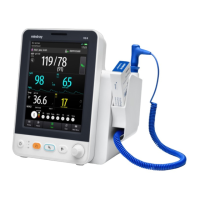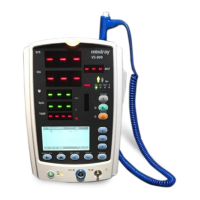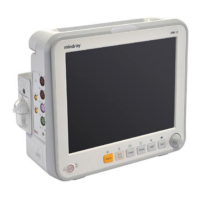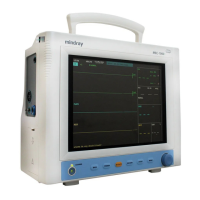• If the measurement fails, “XX” is displayed; if measurement is not taken, “--”
is displayed.
• NIBP numerics in black color with a light outline indicate that the
measurement is old and exceeds the configured NIBP Measurement Timeout
time (see section 16.8.6 Setting Parameter Measurement Timeout). These NIBP
values are not recommended for reference.
9.6 Preparing for NIBP Measurement
9.6.1 Preparing the Patient for NIBP Measurement
In normal use, perform NIBP measurement on a patient who is in the following position:
■ Comfortably seated
■ Legs uncrossed
■ Feet flat on the floor
■ Back, arm and feet supported
For patients taking orthostatic BP measurement, refer to 9.10 Orthostatic BP
Measurement.
(1) The last measurement time
(2) NIBP unit: mmHg or kPa
(3) Select this area to set the patient position and measurement site
(4) Systolic pressure alarm limits
(5) Systolic pressure
(6) Mean pressure (displayed after measurement completed) or cuff pressure (displayed
during the measurement)
(7) Diastolic pressure
(8) Mean pressure alarm limits
(9) Start/Stop NIBP measurement
(10) Sequence information (for Sequence mode): the capital letter indicates the current
phase and the time indicates the current measurement interval
(11) Diastolic pressure alarm limits
(12) Time to the next measurement (for Auto mode and Sequence mode)
• It is recommended that the patient remains calm and relaxes as much as
possible before performing the measurement and that the patient do not
talk during the measurement.
• It is recommended to have the patient sit quietly for several minutes before
taking the measurement.
• For known hypertensive patients, set initial cuff pressure to a higher value to
reduce the measurement time.
• Do not touch the cuff or tubing during NIBP measurement.
• Other factors that have been shown to result in an overestimation of blood
pressure are labored breathing, full bladder, pain etc.
9.6.2 Placing the NIBP Cuff
To place the NIBP cuff, follow this procedure:
1. Verify that the patient category setting is correct. If not, enter the Patient
Management dialog to change patient category. For more information, see
4.2.2 Editing Patient Information.
2. Connect the air tubing to the NIBP connector on the monitor.
3. Select an appropriate cuff for the patient, and then wrap it around the limb
directly over the patient’s skin as follows:
a If your monitor is using inflation algorithm, select cuffs with the
symbol. Using other cuff may lead to incorrect or failed measurements.
b Determine the patient’s limb circumference.
c Select an appropriate cuff by referring to the limb circumference marked on
the cuff. The width of the cuff should be 40% (50% for neonates) of the limb
circumference, or 2/3 of the length of the upper arm or the thigh. The
inflatable part of the cuff should be long enough to encircle at least 50% to
80% of the limb.
d Apply the cuff to the patient’s upper arm or leg and make sure the Φ
marking on the cuff matches the artery location. The cuff should fit snugly,
but with enough room for two fingers to be placed between the cuff and the
patient’s arm (on adults), and loosely on neonates with little or no air present
within the cuff. Otherwise it may cause discoloration and ischemia of the
extremities. Make sure that the cuff index line falls within the range
markings on the cuff. If it does not, use a cuff that fits better.
e Middle of the cuff should be at the level of the right atrium of the heart. If it
is not, use the measurement correction formula to correct the measurement.
For more information, see 9.8.9 Correcting the NIBP Measurements.

